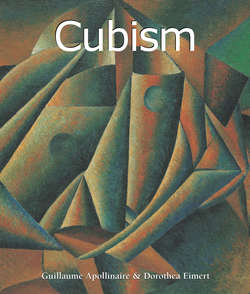Читать книгу Cubism - Guillaume Apollinaire - Страница 4
На сайте Литреса книга снята с продажи.
II. What Is Cubism?
The Analysis of Form
ОглавлениеIn 1907, one painting signalled the prelude to a change in painting: Les Demoiselles d’Avignon. When Pablo Picasso first exhibited this bordello scene with five female figures, even the collector Sergei Shchukin and his friend Georges Braque considered the painting to be “a loss for French painting”. However, the significance of this new view of reality was not lost on Braque. In this work, Picasso crafted for the first time a clear and rational lens without any aesthetic allusions. Taking Cézanne’s analysis of shape further, Picasso fragmented the forms into small cubes. It was the task of the viewer, when standing before the canvas, to put this puzzle of various spatial views together into a whole. Moreover, the muted colours signalled another new direction for painting. However, most of the novelty lay in the independence of the painting from the preconditions given by nature. This was the artist’s response to the changed preconditions of science regarding space and time, using Cézanne’s demand that in nature one should seek out the sphere, the cone and the cylinder as the basis for his compositional ideas. At the 1909 Salon des Indépendants, the critic Louis de Vauxcelles spoke of cubes, and Cubism was born.
The movement underwent many evolutionary steps. Friends Georges Braque and Pablo Picasso said later: “We did not have the intention of creating Cubism. Moreover, we just wanted to express that which moved us… It almost seemed as if we were two mountain climbers who were hanging from a single rope.” Between 1909 and 1912, they separated their art from everything real without turning completely to abstraction, in a phase called Analytical Cubism. In particular, the artists now painted figures and still lifes. They no longer painted an object viewed from one perspective, but rather layered views from many angles in order to capture the subject from all sides. They analysed the object and brought it to the canvas as a fragmented picture. Shape and space melted into one another in one composition of enmeshed, intersected and dissected surfaces. Instead of creating volume, the painters focused on revealing facets and constructing surfaces. The situation captured in the painting became far more indefinite. Some surfaces became transparent, weightless or suddenly transformed themselves into a book or an instrument, something recognisable. With regard to colours, the paintings were dominated by brown, grey and blue hues. Additionally, artists no longer painted in the open air, but rather kept to their studios, where the arsenal for their subjects was already at hand. Later, they no longer arranged their still lifes so that they could paint from reality; rather, they created them out of the imagination, adding numbers and word fragments to the compositions.
Braque and Picasso’s artistic vision brought them to Synthetic Cubism, a movement in which they were joined by Juan Gris. Now, it was no longer about taking the objects apart; now artists set about creating new objects with new materials. One recognised new qualities for works of art, using the most varied materials, even items that were meant to be thrown away. During this period, the collage became a form of painting.
